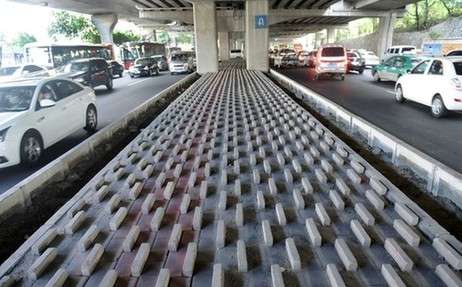当前位置: Language Tips> 流行新词
天桥底下铺满了水泥柱让无家可归者无法栖身,公交站亭里的座椅太窄没法久坐,这样的公共建筑设计曾经让不少人诟病,不过,据说这样的设计就是为了阻止人们过度使用这些公共建筑的。因此,这些建筑也被人们称为“不友好建筑”。

Have you ever stood at a bus shelter and longed to take the weight off your feet, only to be presented with the unpleasant prospect of some kind of metal contraption for leaning on? If you've then wondered how anyone could possibly get comfortable using it, then the answer is simply this – they're not supposed to. In a new wave of design, dubbed hostile architecture, aesthetics are not the only motivating factor when making choices about the form and fabric of particular constructions.
你是否曾经在某个公交站亭,想要坐下歇歇脚,却发现只有一个造型诡异的金属装置可以倚靠一阵?你如果有过这样的经历,那么你可能会想,这样的装置人们用着怎么会舒服呢?答案是,人家本来就没想让你用。建筑设计界新近刮起一阵风,叫做“不友好建筑”,在选择某个特定建筑的形式和材料的时候,美学已不是唯一的决定因素。
It highlights a wide architectural trend in which constructions in public spaces are incorporating design elements deliberately intended to stop people impacting on them. Examples include narrow, slanted bus shelter seats that are barely suitable for sitting on (and would be impossible for a homeless person to sleep on), benches with bulky armrests or protrusions which prevent people from reclining or sitting for long periods, jagged, irregular paved areas in order to deter skateboarders, bollards under bridges and flyovers to prevent skateboarding and sheltering, and studded window ledges which discourage people from sitting or lying down.
这种建筑风格的突出特征是公共场所的建筑会刻意结合一些阻止人们对其产生影响的设计因素。比如,不适宜落座(更不可能让无家可归者在上面睡觉的)狭窄且倾斜的公交站亭座椅,带有笨重扶手或凸起部分、阻止人们斜靠或长时间落座的长凳,阻止轮滑爱好者的参差不齐、不规则铺筑路面,为了阻止轮滑和寻求遮蔽行为而在桥梁和天桥下面铺设的短柱,以及为了阻止人们落座或平躺而设计的布满钉板的窗台。
The expression hostile architecture has pejorative overtones, and is therefore mainly used by people who are skeptical about, if not completely opposed to, the idea. On the other hand, there's also the view that urban design has moved on from crude deterrents like metal spikes, and that more subtle design elements can be valuable in discouraging criminal or anti-social behavior. In these contexts, the same concept is often described as defensive or defensible architecture. (Source: macmillandictionary.com)
“不友好建筑”一词带有贬义,因此多由对这一理念抱有怀疑态度(如果不是完全反对的话)的人使用。从另一方面来看,有一种观点认为城市设计已不再停留在使用金属钢钉等简单粗暴的形式,而且这些精巧微妙的设计元素在阻止犯罪行为或反社会行为方面很有价值。在这种情况下,“不友好建筑”通常都被称为“防御式建筑”。
(中国日报网英语点津 Helen)
上一篇 : 最牛“节能发型”!
下一篇 : 我不想看书!因为我有“密集恐惧症”!
关注和订阅


电话:8610-84883645
传真:8610-84883500
Email: languagetips@chinadaily.com.cn